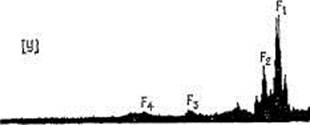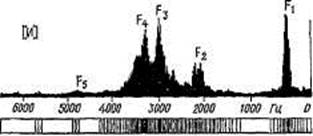Acoustic aspect op speech sounds
Speech sounds have a number of physical properties, the firsf of them is frequency, i.e. the number of vibrations per second.
The vocal cords vibrate along the whole of their length, producing fundamental frequency, and along the varying portions of their length, producing overtones, or harmonics. When the vibrations produced by the vocal cords are regular they produce the acoustic impression of voice or musical tone. When they are irregular noise is produced. When there is a combination of tone and noise, either noise or tone prevails. When tone prevails over noise sonorants are produced. When noise prevails over tone voiced consonants are produced.
The complex range of frequencies which make up the quality of a sound is known as the acoustic spectrum. Bands of energy which are characteristic of a particular sound are called the sound's for-mants..
Perception of the pitch of a speech sound depends upon the frequency of vibration of the vocal cords. The higher the pitch of vibrations, the higher the pitch level. A male voice may have an average pitch level of about 150 cps.1 and a female voice—a level of about 240 cps. The total range of a speaking voice varies from 80 to 350 cps. but the human ear perceives frequencies from 15 cps. to about 20,000 cps. The frequency of sound depends on certain physical properties of the vibrator, such as mass, length and tension.' ,'
The second physical property of sound is intensity. Changes in intensity are perceived as variation in the loudness of a sound. The greater the amplitude of vibration, the greater the intensity of a sound; the greater the pressure on the ear-drums, the louder the sound. Intensity is measured in decibels (dbs).
Any sound has duration, it is its length or quantity of time during which the same vibratory motion, the same pattern of vibration, are; maintained. The duration of speech sounds is usually measured im milliseconds (msecs).
The analysis of a sound frequency and intensity at a definite period of time can be presented graphically with the help of a sound spectrograph. Acoustic characteristics of speech sounds are represented by spectrograms: linear or dynamic and intensity or instant. In instant spectrograms intensity is represented by vertical dimensions,- frequency—by horizontal dimension (Fig. 1).
 * Cycles per second«
* Cycles per second«
In linear representations of intensity spectrograms the strength
o! harmonics is adequate to the blackness of spots: the stronger the
harmonic, the blacker is the spot. _
Both types of spectrograms have certain limitations: _ in linear spectrograms a succession of sounds can be measured but it is diffi-



Fig. i
cult to compare their exact quality. However, they reveal a lot of information about the sound changes in time.
The intensity representations of instant spectrograms cannot be read off with any exactness, but their great mdfft ч$ the possibility to record not only the exact quality, but also the changes of sounds of speech at a particular moment of time.
Spectrographic analysis gives basis for acoustic definitions and classification of speech sounds. One of such classifications was suggested byjR. Jacobson, G. Fant and M. Halle. This classification is not only phonoacoustic but also phonemic
Although acoustic descriptions, definitions and classifications of speech sounds are considered to be more precise than articulatory ones, they are practically inapplicable in language teaching, because
the acoustic features of speech sounds cannot be seen directly or felt by the language learner. Acoustic descriptions, however, can be applied in the fields of technical acoustics. They are also of great theoretical value.
The research work made in acoustic phonetics is connected with 1) the methods of speech synthesis and perceptual experiment for the study of cues of phonemic distinctions and for the exploration of differences in tone and stress; 2) the design of speech recognizing machines, the teaching of languages, the diagnosis and treatment of pathological conditions involving speech and language. The future work in acoustic phonetics will be connected with brain functioning and artificial intelligence. "Experimentation will involve the whole of -speech programming and processing, including the relations between the acoustic level of speech and operations at the grammatical, syntactical, lexical and phonological levels." *
